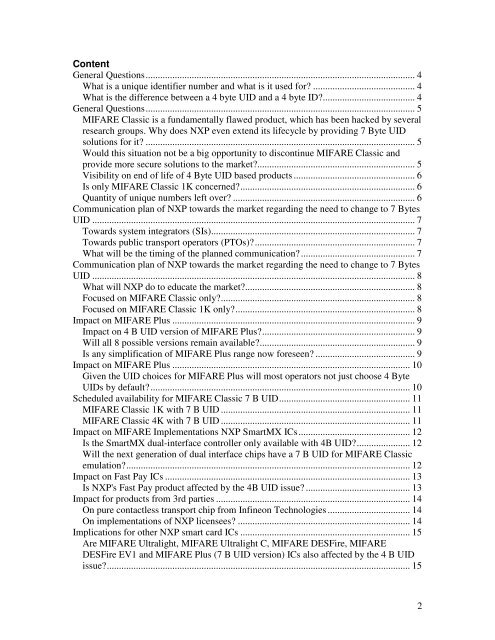4 Byte and 7 Byte UID offering for MIFARE Classic™, MIFARE Plus ...
4 Byte and 7 Byte UID offering for MIFARE Classic™, MIFARE Plus ...
4 Byte and 7 Byte UID offering for MIFARE Classic™, MIFARE Plus ...
Create successful ePaper yourself
Turn your PDF publications into a flip-book with our unique Google optimized e-Paper software.
Content<br />
General Questions............................................................................................................... 4<br />
What is a unique identifier number <strong>and</strong> what is it used <strong>for</strong>? .......................................... 4<br />
What is the difference between a 4 byte <strong>UID</strong> <strong>and</strong> a 4 byte ID?...................................... 4<br />
General Questions............................................................................................................... 5<br />
<strong>MIFARE</strong> Classic is a fundamentally flawed product, which has been hacked by several<br />
research groups. Why does NXP even extend its lifecycle by providing 7 <strong>Byte</strong> <strong>UID</strong><br />
solutions <strong>for</strong> it? ............................................................................................................... 5<br />
Would this situation not be a big opportunity to discontinue <strong>MIFARE</strong> Classic <strong>and</strong><br />
provide more secure solutions to the market?................................................................. 5<br />
Visibility on end of life of 4 <strong>Byte</strong> <strong>UID</strong> based products .................................................. 6<br />
Is only <strong>MIFARE</strong> Classic 1K concerned?........................................................................ 6<br />
Quantity of unique numbers left over? ........................................................................... 6<br />
Communication plan of NXP towards the market regarding the need to change to 7 <strong>Byte</strong>s<br />
<strong>UID</strong> ..................................................................................................................................... 7<br />
Towards system integrators (SIs).................................................................................... 7<br />
Towards public transport operators (PTOs)?.................................................................. 7<br />
What will be the timing of the planned communication? ............................................... 7<br />
Communication plan of NXP towards the market regarding the need to change to 7 <strong>Byte</strong>s<br />
<strong>UID</strong> ..................................................................................................................................... 8<br />
What will NXP do to educate the market?...................................................................... 8<br />
Focused on <strong>MIFARE</strong> Classic only?................................................................................ 8<br />
Focused on <strong>MIFARE</strong> Classic 1K only?.......................................................................... 8<br />
Impact on <strong>MIFARE</strong> <strong>Plus</strong> .................................................................................................... 9<br />
Impact on 4 B <strong>UID</strong> version of <strong>MIFARE</strong> <strong>Plus</strong>?............................................................... 9<br />
Will all 8 possible versions remain available?................................................................ 9<br />
Is any simplification of <strong>MIFARE</strong> <strong>Plus</strong> range now <strong>for</strong>eseen? ......................................... 9<br />
Impact on <strong>MIFARE</strong> <strong>Plus</strong> .................................................................................................. 10<br />
Given the <strong>UID</strong> choices <strong>for</strong> <strong>MIFARE</strong> <strong>Plus</strong> will most operators not just choose 4 <strong>Byte</strong><br />
<strong>UID</strong>s by default?........................................................................................................... 10<br />
Scheduled availability <strong>for</strong> <strong>MIFARE</strong> Classic 7 B <strong>UID</strong>...................................................... 11<br />
<strong>MIFARE</strong> Classic 1K with 7 B <strong>UID</strong> .............................................................................. 11<br />
<strong>MIFARE</strong> Classic 4K with 7 B <strong>UID</strong> .............................................................................. 11<br />
Impact on <strong>MIFARE</strong> Implementations NXP SmartMX ICs.............................................. 12<br />
Is the SmartMX dual-interface controller only available with 4B <strong>UID</strong>?...................... 12<br />
Will the next generation of dual interface chips have a 7 B <strong>UID</strong> <strong>for</strong> <strong>MIFARE</strong> Classic<br />
emulation?..................................................................................................................... 12<br />
Impact on Fast Pay ICs ..................................................................................................... 13<br />
Is NXP's Fast Pay product affected by the 4B <strong>UID</strong> issue? ........................................... 13<br />
Impact <strong>for</strong> products from 3rd parties ................................................................................ 14<br />
On pure contactless transport chip from Infineon Technologies .................................. 14<br />
On implementations of NXP licensees? ....................................................................... 14<br />
Implications <strong>for</strong> other NXP smart card ICs ...................................................................... 15<br />
Are <strong>MIFARE</strong> Ultralight, <strong>MIFARE</strong> Ultralight C, <strong>MIFARE</strong> DESFire, <strong>MIFARE</strong><br />
DESFire EV1 <strong>and</strong> <strong>MIFARE</strong> <strong>Plus</strong> (7 B <strong>UID</strong> version) ICs also affected by the 4 B <strong>UID</strong><br />
issue?............................................................................................................................. 15<br />
2









